Peppers are some of the most interesting plants that you can easily grow at home. We are all familiar with the bell pepper and the spicy jalapeño. But have you heard of any of these weird peppers? There are thousands of pepper varieties around the world, with the number constantly growing.
Gardeners can easily crossbreed two peppers types to create something new. Check out these 9 weird pepper varieties that you can grow yourself at home!
The sugar rush stripey is one of the only varieties of pepper known to have stripes when ripe. It changes from light green to peachy orange and finally to contrasting orange and red stripes.
Hailing from the C. baccatum species, this pepper was a variant of the sugar rush peach pepper. The flavor is similar, with lots of sweetness and medium heat. The strange world of peppers just keeps getting better!
The peachgum tiger pepper variety is one of the most bizarre peppers that we have grown (so far). The pods ripen from deep purple, almost black, to a peachy orange color.
Read more about the 7 Pot Bubblegum here
To top it off, the calyx of the peppers extends in a flower shape and retains the dark purple color of the unripe pods. This unstable cross likely comes from crossing the bubblegum pepper with one of the dark foliage C. chinense varieties. Weird, super spicy, and quirky – what’s not to love?
Translated from German, this name means “yellow tomato pepper.” And indeed, it does look more like a wrinkly heirloom tomato than a pepper! The flavor is sweet and delicious, much like a bell pepper. It also has nice thick walls and a crunchy texture.
They have no heat at all, making them a great option for the family garden. They are moderately prolific, but not super productive. Try the paradeisfrüchtiger gelber pepper as a quirky replacement for one of your sweet pepper plants.
Fish peppers are known for their incredible variegated foliage. The plant leaves are green with white stripes and spots throughout. They make a beautiful decorative plant.
But the colors don’t stop on the leaves. Fish peppers themselves go through an incredible transformation as they ripen. The peppers turn from striped white and green to orange and finally to a deep red.
Fish peppers also carry an interesting history. Learn all about fish peppers in our article about them here.
The black panther pepper was born from a cross. The original two pepper varieties were the bhut jolokia (ghost pepper) and the pimenta da neyde. The result is a fiercely spicy pepper with a strange and unique ripening pattern.
The peppers will start off almost entirely black in color, eventually ripening to a bright red or orange (depending on the type). This coloration is thanks to the genetics from the pimenta da neyde, an almost entirely black plant, both foliage and peppers. Many more amazing varieties were born from breeding with the neyde pepper!
The Macedonian rezha stands out due to the intense corking on the pepper’s skin. The genetics of the rezha give the peppers their distinctive look, so the white marks are not unhealthy or inedible.
The peppers are also large, growing to 8 inches or longer. The amount of corking varies on the peppers, but they typically grow to be covered completely by the stretch marks. The rezha is another odd spicy pepper that you can easily grow at home.
7. Carolina Reaper
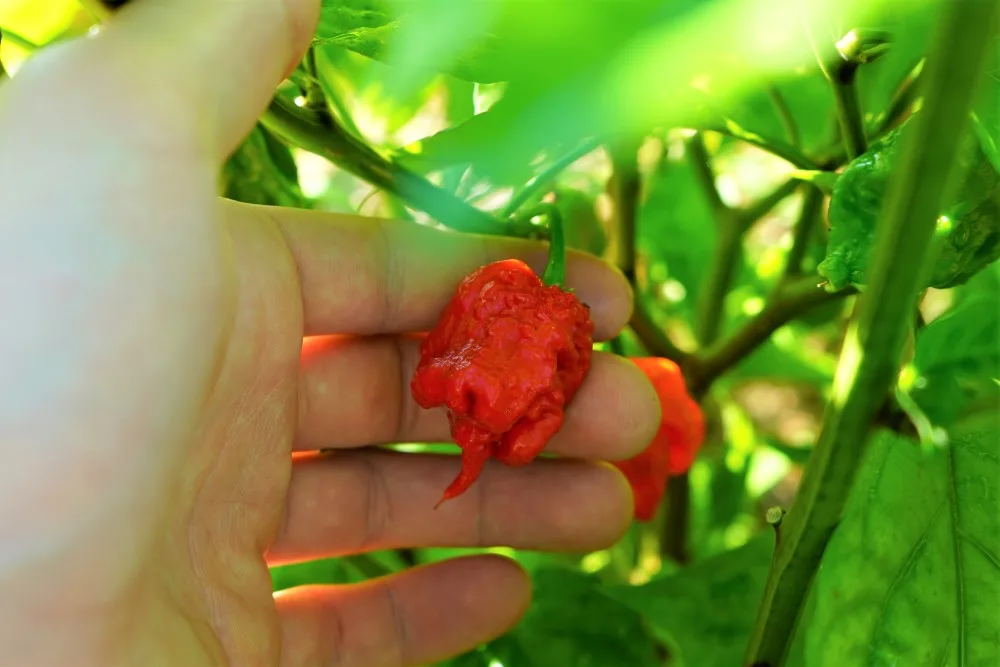
Through the methods of plant breeding, people have been able to produce strange hybrid varieties of existing peppers. The Carolina reaper held the Guinness world record for the world’s hottest pepper for about 10 years. It has since been beaten by Pepper X.
Clocking in at a whopping 2.2 million SHUs on the Scoville scale, the reaper is mind-blowingly spicy. The pepper also looks like it comes straight from the underworld.
You better be brave to grow (or even touch) these peppers. One tiny drop of pepper juice from a reaper can cause serious pain, even on your skin. Beware!
Want to see something even more strange? Check out the purple reaper here!
8. Habanada Pepper

Taking a hard left turn from the hottest pepper, the habanada pepper was bred to have the flavor of a habanero, with no heat. These peppers come in at 0 SHUs on the Scoville scale, but they have the familiar, floral flavor of the habanero pepper.
The habanada also has a beautiful orange color with an interesting wrinkled texture. They may look like a hot pepper, but they’re no hotter than your standard green bell pepper! Grow them yourself and fool your friends into thinking you can handle eating a raw habanero!
9. Jay’s Peach Ghost Scorpion
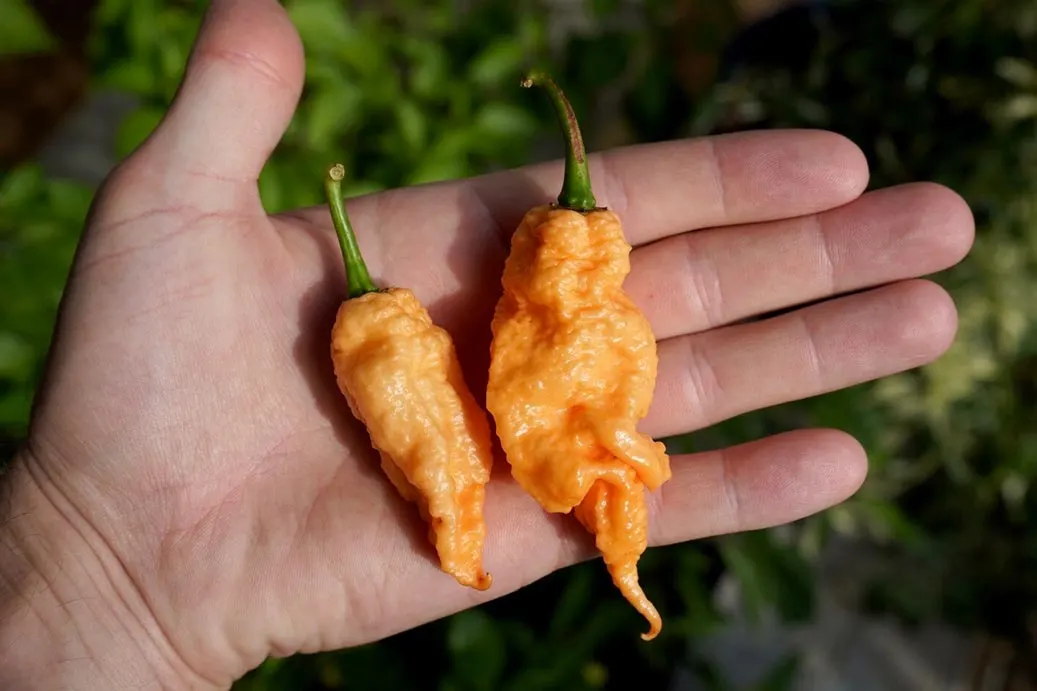
Perhaps our favorite ‘ghost’ variety, the peach ghost scorpion was created by Jay Weaver. This gnarly-looking variety was an accidental cross between the bhut jolokia (ghost pepper) and a scorpion pepper.
Jay’s peach ghost scorpion plants are extremely vigorous and produce lots of pods with peculiar shapes. Ideal fruits are over 3.5″ long with long, curly tails and wrinkly skin. The peach color gives a false sense of sweetness – make no mistake, these peppers are hot!
There are many, many more pepper varieties from around the world, many of which are quite strange. This list of weird peppers is only scratching the surface!
Check out the easiest peppers to grow in our article here.
If you’re interested in exploring more of the bizarre chili peppers that are out there, try one of these great seed suppliers:
- Bohica Pepper Hut
- Towns-End Chili & Spice
- Matt’s peppers
- White Hot Peppers
- Fatalii Seeds (not US-based)
See more places to buy pepper seeds online in our post here. Enjoy!

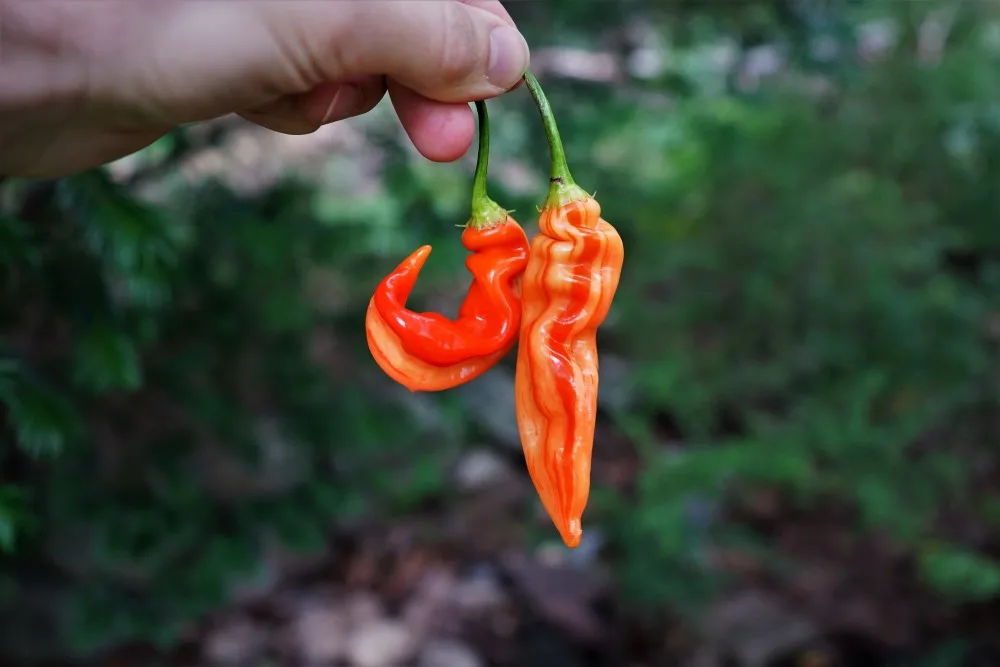
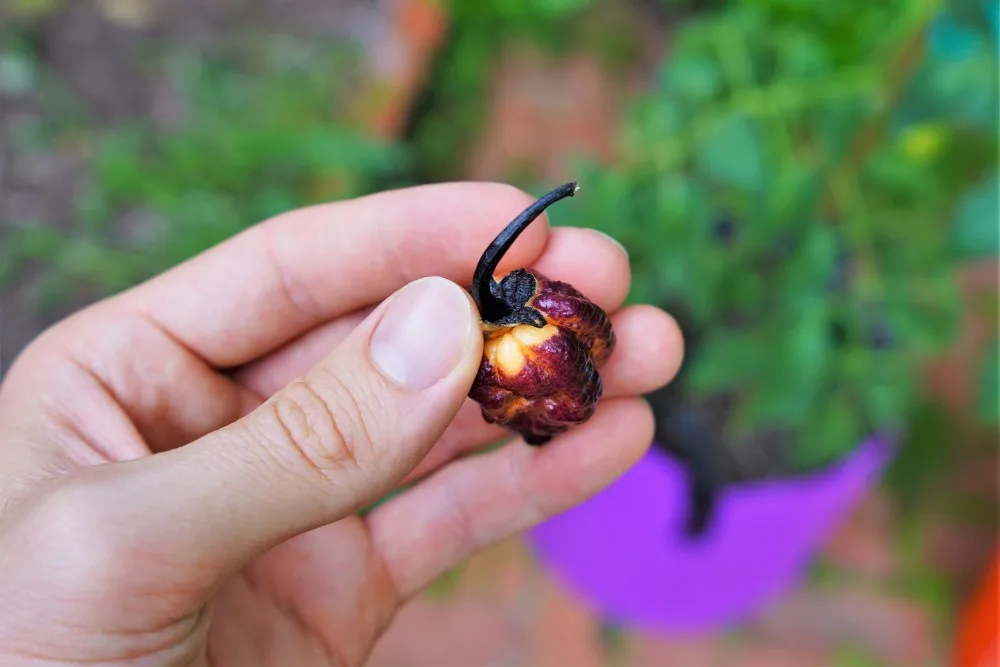

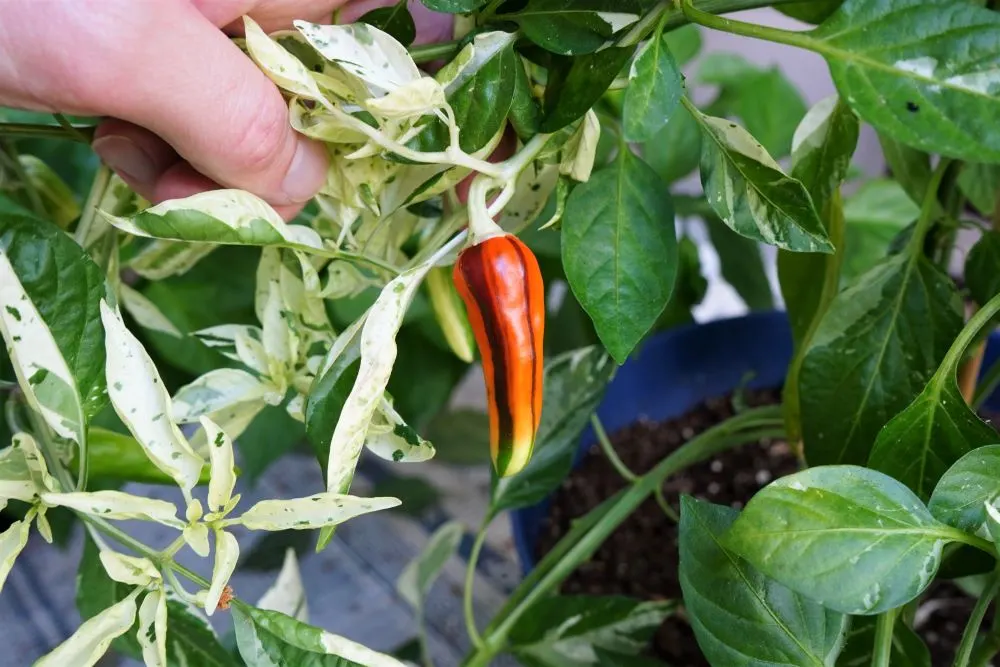
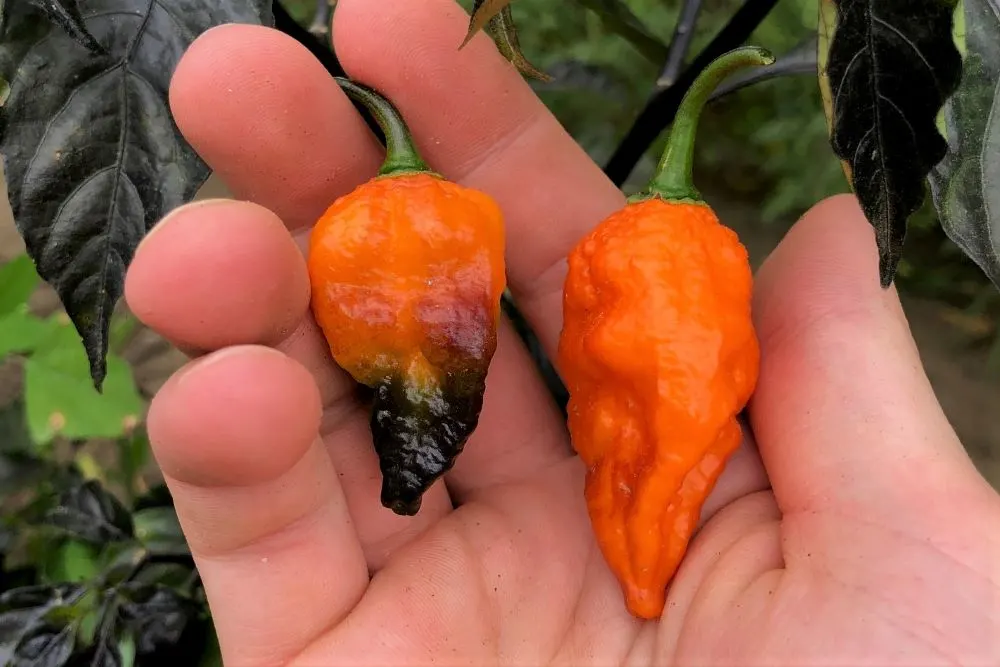
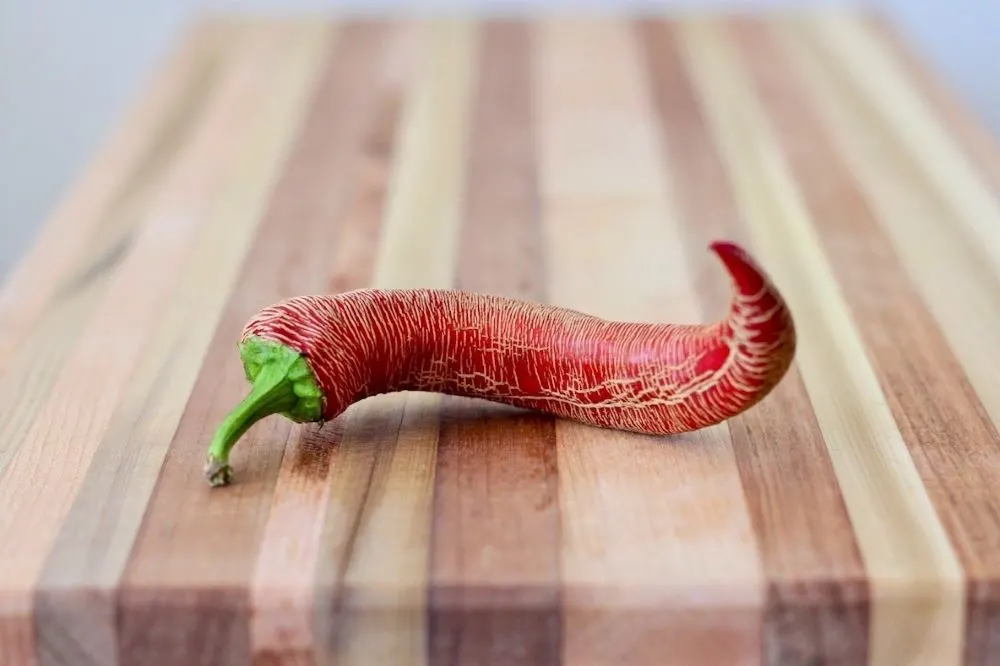

David Niemi
Wednesday 3rd of April 2024
I have a friend who grew up in Trinidad and explained that peppers similar to Habanada have long been important in their cuisine. The idea is to match the aroma and taste of a Habanero-class pepper but without the heat. These are mixed in to meet the heat tolerance of who is going to eat it -- for example, young children, people who grew up without hot peppers around, or anyone who does not like a lot of heat in their food. All the while, the rest of the taste profile is consistent.
Other peppers with a similar taste and purpose include "Aji Dulce", "Arroz con Pollo", "Trinidad Sweets", "Tobago Seasoning", and "Zavory", and many of the more generically named "Seasoning Peppers" or "Spice Peppers". Some of these may have a little bit of heat but all are obviously much, much milder than an actual Habanero. For those of you in a cool climate, some of this class of peppers unfortunately have a rather long growing season and are especially cold-intolerant, more so than ordinary Habaneros (I do not recall whether this applies to Habanadas specifically).
Matt's Peppers
Wednesday 3rd of April 2024
Thank you for the mention!
Ree
Saturday 9th of December 2023
Know any good peppers that are hot but flavorful and easy to grow in either western or Eastern Washington state? Most of my family likes peppers, from non-spicy and sweet(ish) to burning. But all preferences include a nice flavor. Want some ideas for home gardens or deck planters to give family for birthdays and Christmas. Happy to find the tomato pepper and fake habanero here, as well as the cool looking spicy ones and the sugar spicy pepper. Got anymore that you could reccommend?
peppergeek
Monday 11th of December 2023
This is an article about our favorite tasting peppers - they should all be grow-able in your climate.
Cruz
Wednesday 12th of July 2023
I would take Fatalii off your list of places to buy seeds. I lost to US Customs (supposedly) two packages of seeds coming from him, and he won't replace them. Even with paying extra for tracking numbers, the tracking system over there is no good and I could never learn what happened to my seeds (if he even sent them). It's too much of a risk to recommend even if he has interesting varieties.
peppergeek
Thursday 13th of July 2023
Thanks for sharing that - I know he stopped shipping to the US for this exact reason. It's unfortunate, but still a good source for European buyers
James
Wednesday 12th of July 2023
The Peach Ghost is one of my favorite peppers. I use them in BBQ sauces, pickled alongside serranos, and added in to make a hot raspberry jam. Can't recommend this one enough.